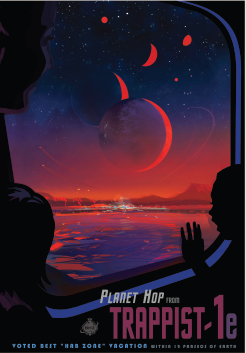Last updated April 6, 2017 at 12:58 pm
NASA’s latest official announcement about the discovery of new exoplanets holds a lot of potential, writes astronomer Dr Alan Duffy.
The discovery by NASA of 7(!) potentially habitable Earth-sized worlds around a nearby star TRAPPIST-1 is amazing. To find a distant Solar System as complex as our own is newsworthy but the implications are even greater as it means there are many more places for life to arise in our Milky Way.
The seven planets, ranging from 0.4 to 1.4 Earth masses each, are orbiting a tiny ultracool dwarf star. In the meagre light of TRAPPIST-1, barely a thousandth of the output of our Sun, these worlds huddle closely. Three of the worlds lie within the so-called habitable zone, where water can exist on the surface as it’s not too close to be too hot for water and not too far such that the water freezes. With reasonable modelling of the protective blanket of the atmosphere (as occurs with the Earth!) all seven worlds can potentially sustain liquid water. And on Earth where there’s water there’s life.
 Planets orbiting another star than our Sun are known as exoplanets, and these exoplanets orbit their star so closely that the entire system can fit within the gap between our Sun and its closest planet, Mercury. It’s a miniature version of our Solar System, but with the star more similar in extent to Jupiter and the seven Earth-sized worlds more akin to those Moons of Jupiter.
Planets orbiting another star than our Sun are known as exoplanets, and these exoplanets orbit their star so closely that the entire system can fit within the gap between our Sun and its closest planet, Mercury. It’s a miniature version of our Solar System, but with the star more similar in extent to Jupiter and the seven Earth-sized worlds more akin to those Moons of Jupiter.
On Earth we can see our neighbouring planets as points of light, distinguished from stars by not twinkling. In TRAPPIST-1 the worlds are so close that the neighbours can appear in the sky bigger than a Full Moon. Forget having to decide if they were twinkling to identify them, you could see continents and even weather on them!
Under that sickly red star, the colour that an ultracool dwarf shines at, things might not look that appealing especially compared to our yellow star (which has a hotter surface, continue to heat up and stars appear blue). Yet this faint star will still be slowly burning its fuel billions of years after our Sun is a long forgotten memory. In fact, these dwarf stars last for trillions of years (we think, as there’s not been long enough in the universe to see one end yet!) meaning there’s plenty of time for life to arise on these planets if conditions are right.
The exoplanets were found by blocking a tiny amount of the star light as they pass between us and the faint dwarf. If you keep seeing that dip (or transit) repeating weeks later then you know you’ve potentially got an exoplanet with a year that lasts that amount of time. The more light it blocks, the bigger the extent of planet. With some VERY careful analysis you can infer the existence of 7 entire worlds.
The sheer number of dwarf stars, vastly outnumbering Sun-like stars, means that the discovery that they can host Earth-sized worlds (let alone 7 of them) will vastly dominate the types of stars in our Milky Way where we should be looking for life.
Before locking in your tickets to visit, and pack some good books as with even our fastest rocket it would take about a million years to travel those 40 light years, keep in mind these worlds might be unpleasant. That’s because the exoplanets are so close to their star that they are tidally locked, just as our Moon is to the Earth, meaning the same side always faces the star and gets cooked as the other side potentially freezes. Critically an atmosphere can distribute that heating around making things more hospitable.
That atmosphere is also the next key observation to learn more about the habitability of these worlds. The James Webb Space Telescope, to launch in October 2018, will be able to see starlight that shines through the atmosphere of these worlds. The atmosphere leaves a chemical fingerprint in the starlight, seen as absorptions lines in the spectrum of it similar to barcode like stripes in the rainbow of the starlight. Signatures of unusual chemistry mixes, such as methane and oxygen floating together which usually only lasts a century, indicate that something is replenishing that methane. That something could be life.
You can bet that TRAPPIST-1 will be one of the first systems on the list to be surveyed.
All image credit: NASA/JPL-Caltech
Written by Alan Duffy
Did you like this blog? Follow us on Facebook, Twitter and Instagram to get all the latest science.





























































































































































































































































































































































































































































































